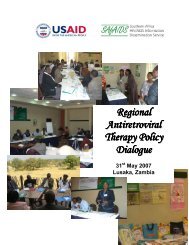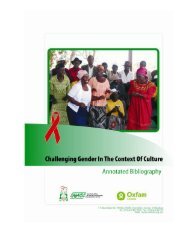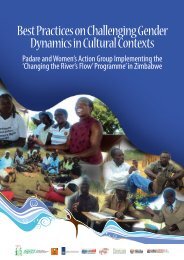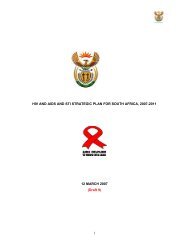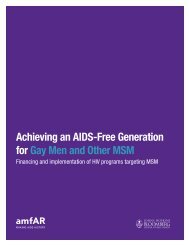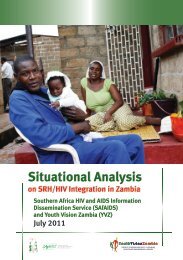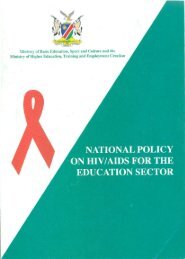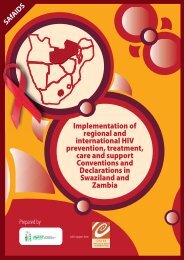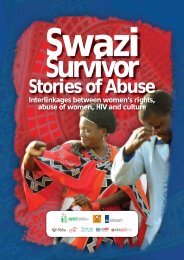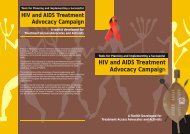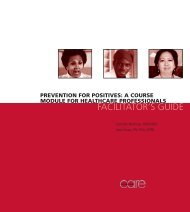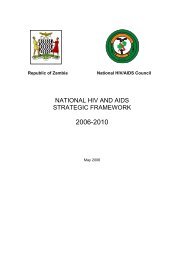Exploring issues: Exploring innovative perspectives on culture in order to re-instil positive values andredefine negative cultural practices, with a view to upholding children's rights and putting in placestrategies to prevent the spread of HIV. The roles of the individual, the family and, in particular, thecommunity, and how they relate to national and international institutions, are important in this regard.This handbook will further explore positive cultural practices in favour of the rights of the child.Developing skills: Trainers and facilitators can further develop their skills, giving them a broaderknowledge base on the rights of the child,culture and HIV in a local context. Although this handbook hasnot been produced for children as trainers, the information can help children build their knowledge onrights issues, community life, cultural issues and HIV. This will allow them to reflect, deepening theirperception and understanding of themselves.Children need to know that they are entitled to their rightsand to learn to make sure that these are respected.Processing information: Processing information enables workshop participants to recognise an issueor problem, and then develop an action plan that helps to deal with the issue at hand. The role-playsessions, community maps of positive and negative cultural practices, and the learning games, willenable participants to process issues in relation to HIV,within both a rights and a cultural perspective,andto develop their own solutions to problems.Having fun while learning: The participatory learning methodology used throughout this handbookoffers specially designed exercises and games, in order to maximise the benefit of the learning andtraining experience. It is community focussed and leaves a lasting and strong impact on trainers,participants and other stakeholders and beneficiaries. There are plenty of fun exercises which areintended to make the training an interesting,stimulating and memorable experience.Cascading knowledge and skills: Those who have been trained in the use of this handbook will gainknowledge and skills that enable them to return to their organisations or communities and further shareawareness of child rights and HIV.This is an important element of the cascade and trickle-down processof skills building that this handbook employs. The aim is to raise community awareness andpreparedness around issues of children’s rights and HIV.Structure and MethodologyThis handbook is guided by the following principles that encourage learning by doing, action andhaving fun – a cascading method of empowerment that seeks to benefit even the hardest to reachcommunities. Some features of the methodology are:• Adaptation of the Kelleher framework analytical approach, that empowers the individual and thecommunity to strengthen responses to issues that affect them most, using tools and resourcesthat contribute to favourable environmental change. Each of the activities has a ‘group sharingsection' that promotes this approach, allowing participants to share their experiences andcontribute, in a positive way, to strategies for creating positive change on the ground, usingexisting networks and legal instruments. Section 3 adapts the Kelleher framework to explorecommunity solutions for children around Identity and education. See Appendix 1 for theadapted Kelleher framework diagram.• Programmes that target children are important and more meaningful if they incorporate thevoices of children themselves. Much of the content in this handbook is presented through theeyes of children and adults from the community, in relation to the impact of HIV, stigma anddiscrimination, children’s rights, parental and community roles, positive and negative culturalpractices and violations of children.02Handbook on Child Rights and Culture
• Conventions, charters, declarations and national policies are referred to as a means of validatingand encouraging on-going programming efforts in relation to culture, rights and HIV. Althoughmuch legislation exists to uphold the rights of children, these laws only have meaning when theyare implemented at national and community level. The training should facilitate CBVs to ensureproper implementation of child rights at the community level, and especially to take account ofthe rights of the0-8yearolds,who are often overlooked.It is important that these documents arereferred to in order to enhance programming efforts, and also to re-visit them whenevernecessary, to incorporate new features or make amendments as the epidemic evolves. In thishandbook, the UN Convention on the Rights of the Child (CRC), the Millennium DevelopmentGoals (MDGs), the African Charter on the Rights and Welfare of the Child (ACRWC) and all childfriendlylegislation at national level are all recognised.• This handbook is also influenced by relevant research on children’s rights, culture and HIV. Theresearch findings used are mostly from Zimbabwe, but the same issues apply throughoutsouthern Africa. Besides the community dialogue reports, a wealth of material was reviewed andanalysed, but only very relevant information was extracted on culture, HIV and the role of thecommunity in responding to children’s rights. This research review in itself prompted a call forfurther child-focussed studies into child rights and how they interface with culture,in the contextof HIV at national level, because existing information is scarce, particularly in relation to the 0-8years age group. Fifteen percent of orphans in Africa are aged 0-4years and 35% are aged 5-9years.About one third are orphaned due to AIDS (Healthlink,2004).Section1• Younger children are greatly influenced by the older children around them.Thus, educating olderchildren to know their rights has a cascade effect on the younger ones, for whom the olderchildren are role models.When their role models are aware of, and willing to champion, their ownrights and take on the responsibilities associated with them, younger children grow to adoptdifferent behaviour norms. They assume the existence of child rights, instead of accepting thembeing denied or questioned. The comic book: Finding our Rights: Rudo and Temba's Story, thataccompanies this handbook, is designed to be used in smaller groups with children below 8 yearsof age,to make them aware of how child rights can support them.• This handbook provides trainers and facilitators with a unique approach that helps to make thetraining lively, applicable and beneficial to participants. The characters are referred to as childadvocates,and they are based on real life situations and stories that can help transform child rightsadvocacy into a fun and tangible reality, for both the trainers and CBVs, also helping to lighten agenerally heavy topic. These characters can also be ‘taken home’ to use in the community, wheneducating younger children about their rights.• Research has shown that many ethnic groups are present in varying numbers in communitysettings, and we are beginning to witness modifications to existing social networks. For example,Chinese families and businesses are establishing themselves on farms in community districts andin peri-urban areas of Zimbabwe.HIV has no boundaries,therefore it was considered important inthe drafting of this handbook to reflect the different ethnic groups as equal partners in theresponse.The introduction of the characters facilitates the representation of a southern African community setting,showing the link between the community areas and the peri-urban settings where legal,government andNGO support structures are based, and the outside, usually 'foreign', world where internationalconventions and declarations are ratified. This is a direct application of the Kelleher Framework thatenables trainers and CBVs to bring alive the content of this handbook, and to make it real and relevant tothemselves and their communities through use of a 'mentor' or 'elder', while demonstrating the widernetwork of relationships between the individual, the community and the legal structures that promotebehaviour change.Handbook on Child Rights and Culture03



